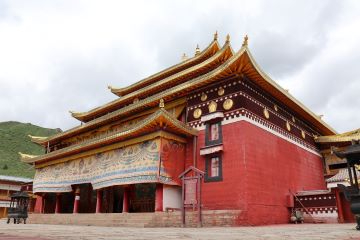Zigong Salt Museum

Name in Chinese: 自贡盐业博物馆 Zì Gòng Yán Yè Bó Wù Guǎn [dzi gɔ: jæ je bɔ: wu: gwæ]
Duration of Tour: One Hour
Location: No.107, Jiefang Road, Ziliujing District, Zigong Prefecture, Sichuan Province
Highlights: the History of China’s Salt Industry and the Traditional Architectural Practice
Reputations: A State-level Historical and Cultural Relic Site under Protection, One of China’s Top-class Museums
Located in downtown Zigong, the salt museum is associated with the history of China’s ancient salt industry. Zigong is well-known as the Millennium-old Salt Capital. It boasts a long history of salt manufacturing that could be traced back to 1,900 years ago. The salt product could be classified into three types, namely the sea salt, the mine salt and the well salt. Unlike the coastal region, Zigong Prefecture produces a large amount of well salt. In March 1959, the late leader of China, Deng Xiaoping gave a proposal to found the museum at Xiqin Guildhall. In October 1959, it was opened to the public. The museum displays a collection of articles related to the history of local salt industrial development. The articles on display are mainly the tools and a variety of equipment used in drilling wells, pumping brine solution from the salt bed or dome, channeling brine solution, extracting and refining salt. Some ancient documents are also on exhibition.
Xiqin Guildhall
Xiqin Guildhall was also called Shaanxi Temple or Guandi Temple. Xiqin refers to Shaanxi Province. The guildhall was built by salt merchants from Shaanxi Province. The construction started in 1736, and completed in 1752. It lasted from the first year of Emperor Qianlong’s reign(1736-1795) to the 17th year. Xiqin Guildhall used to the place where the merchants and countrymen from Shaanxi Province gathered for meetings. It was expanded during the reign of Emperor Daoguang(1821-1850). The main building of the guildhall was designed in a meticulous and peculiar way. It embodies the features of both official and folk architectural styles in the feudal imperial society. The architectural complex is richly decorated with wooden carvings, colorful murals and stone sculptures. It is well-known as the gallery of both historical documents and artworks.
The Tools for Drilling Wells
There are over 400 various drilling tools exhibited in the museum. The tools are classified into 130 types. Each had its own function. Some were used for chiseling,, some for repairing, some for measuring, etc. The museum also exhibits some historical documents related to the local salt industry. Yankoubu is an original record of the local well salt production. It illustrates the process how the well salt was produced in ancient time. According to the record, ancient people started to drill salt wells in Sichuan Basin around 2,250 years ago.
Shenhai Salt Well
Shenhai Salt Well is situated 4 km(2.5 miles) away from the salt museum. The well was drilled in 1835. As the deepest one in the 19th century in the world, Shenhai Well is 1,001.42 meters(3285.5 feet) in depth. It shows the superb technology of drilling wells in ancient China. The well did not only produce salt, but also natural gas. Its Chinese name indicates what it produced and how deep it is. In 1988, the well was also listed as a National Key Historical and Cultural Relic under Protection.
Travel Tips:
How to Get to Zigong Salt Museum
The salt museum is located in downtown Zigong, about 190 km(118 miles) to the southeast of Chengdu. It takes around two and a half hours to get to the museum from Chengdu.
Opening Hours:
8:30 A.M.---5:30 P.M.
Related Articles:
Zigong Travel Guide
Zigong Dinosaur Museum
Author: Tina Luo
Update:
